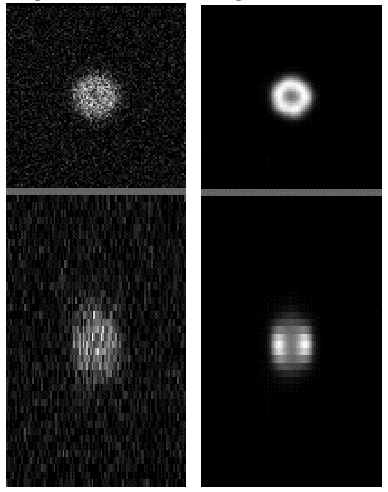Deconvolving bead images
A typical observation is that when one tries to deconvolve bead images using the Point Spread Function (PSF) distilled from them (see Recording Beads), the ideal spherical appearance is not restored.

Original and deconvolved bead image. Top: XY slice. Bottom: XZ slice.
First of all, the above result would be expected only for beads larger than the recommended ones for distilling a PSF. For calibration (PSF distillation) purposes, Sub Resolution beads should be used and, when their properly sampled images are deconvolved, they should ideally provide a single VoXel!!!
If your image is sampled by voxels of 60×60×150 nm, a 250 nm diameter bead would look a bit smaller than 4x4x2 voxels once it is properly deconvolved!!! Don't expect a big sphere to appear...
Explanation
The PSF has an aspect ratio of about 4/1. This means that a nearly SubResolution sphere is distorted in such a proportion along Z when measured; that's your loss of resolution. To restore the original situation, you need a ResolutionImprovement of a factor of 4 along Z. Even more, because if you gained some resolution in XY, let's say a 50 %, you will need another 50 % also along Z to recover the spherical aspect ratio, i.e. a boost factor of 6. That is a lot!!! Such a resolution improvement can only happen with a lot of risk of generating artifacts, for example by enhancing noise. It is possible: in HuygensProfessional you may find Restoration Methods (like the QMLE algorithm) that can restore the image a lot. But the results are more unpredictable with noisy images, and these are recommended only for almost noise free images.
But this effect in the aspect ratio of tiny objects does not translate similarly to larger ones!!! When you replace every subresolution voxel by that elongated prism, they will overlap each other when "building up" larger objects, and the final "error" is not so large.
Of course, you can also think in not correcting too much in XY to make the improvements in Z look better (more 1/1 final aspect ratio), but the aspect ratio is not what we want. The restoration looks for a ResolutionImprovement in all directions, as much as possible!!!
Another possible solution would be forcing the restoration including the constrain that the objects are SubResolution spheres. But this will only apply to this particular kind of images, and can not be used in a general RestorationMethod for all microscope images. Otherwise it would generate new objects that we do not know for sure that exist in the original, and that is not the purpose of ImageRestoration.
Try it yourself
You can made tests by using, as a PSF for the deconvolution of your beads, both (A) an averaged bead and (B) a PSF distilled from it. Deconvolving some of your beads specially using (A) but also with (B), provides after many iterations objects that are almost punctual. (If you can, better use the QMLE algorithm, that for simple, not very noisy objects, provides very fast and reliable results).
After infinite iterations they should be the size of about one single voxel. That is, of course, the mathematically expected result from using (A), because an image deconvolved with itself is a single point. Deviations from this ideal result are caused by the experimental differences between a real bead and the average of all beads used as PSF (A). Using (B) provides images larger than a voxel, but not too much, providing that your calibration beads are close to the Sub Resolution ideal.
How things can be worse
Please keep in mind that in your images additional problems may affect the image; your results may be improves noticeably if those are addressed:
- There could be large spherical aberration, probably caused by a refractive index mismatch, distorting the PSF and therefore the bead images: see Mismatch Distorts Psf and Mismatch In Recorded Beads. Moreover, apart from the asymmetry along the optical axis expected for such a situation, in some cases there is another lateral asymmetry that could be caused by misalignments of the optics. Such asymmetries can be better observed in XZ or YZ slice views.
- This mismatch is likely also causing geometrical distortion, elongating the objects, for which Huygens does not automatically correct. Please see Fishtank Effect. By reducing the sampling distance by the correspondent factor (the quotient of refractive indices) the aspect ratio is improved.
- When using large beads these may act like little lenses due to the high Refractive Index of latex, giving further trouble the algorithms do not correct.
- The deconvolution can go completely wrong if the image is not properly described. This happens more frequently than you would think, for example if the Z-stage is not properly calibrated. See Calibrate Axial Distances.
- A frequently occurring problem is also Z-drift, which is often due to thermal or other instabilities of the microscope. You can detect this by running a time course at one focal plane for one hour. See Object Stabilizer.
Huygens can correct to a certain extend confocal and multiphoton images for this. See Zdrift Correction.
- With the recording of multichannel beads, it can become clear that channels are shifted with respect to one another in XY and/or Z. See Chromatic Shift Corrector.
More information
- Beads Deconvolution Example
- Resolution Improvement
- See also the FAQ "How large a resolution improvement can be expected from the Huygens deconvolution?".
- and the FAQ "Can a small sphere-like object look again like a sphere in X Y Z after deconvolution?"
- This paper in 'Methods' presents confocal bead measurements and deconvolution results at different pinhole sizes and RI conditions: https://doi.org/10.1016/j.ymeth.2016.11.003
Search the FAQ for "resolution gain".
